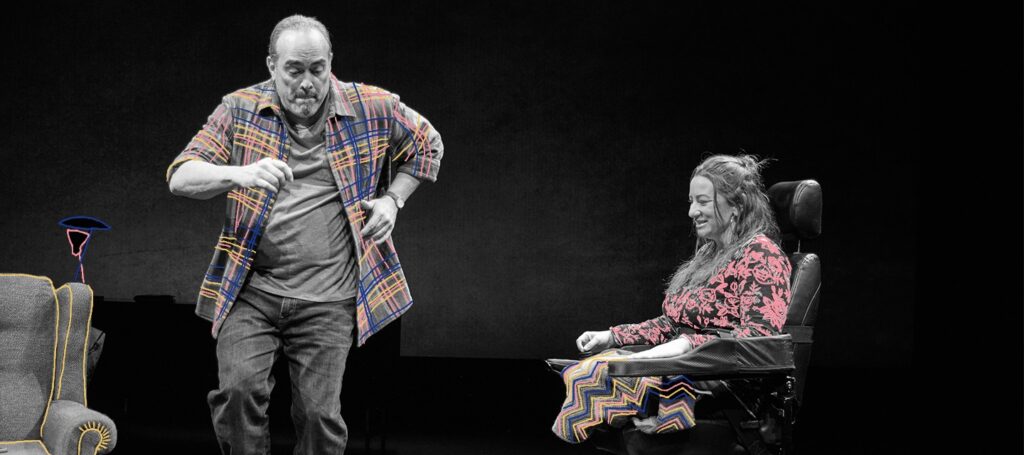


The Gorgeous ‘Cost of Living’ Depicts Disability in Groundbreaking Ways
Last season, Martyna Majok stunned audiences with her gripping portrayal of immigrant life in Sanctuary City; now her earlier play, Cost of Living, which won the Pulitzer Prize for Drama in 2018, is making its Broadway debut–as is the playwright. Last year I extolled her work as “off-Broadway at its best,” and this year I am thrilled to see her at the Samuel J. Friedman Theatre, on the big stage.
Although I prefer the experimental, more poetic, quality of Sanctuary City, the more conventionally structured Cost of Living feels at home on Broadway.
In so many ways though, Cost of Living is not at all typical Broadway fare: the play depicts two duos of one disabled person and their able-bodied caregiver. John (Gregg Mozgala), a graduate student, hires Jess (Kara Young), a woman in need of extra money; Ani (Katy Sullivan) reluctantly allows her ex-husband Eddie (David Zayas) to be her temporary nurse. Both John and Ani use power wheelchairs. Most significantly, John and Ani are both played by disabled actors.
I want to pause for a second to note the extreme significance of this play, about disability and caregiving, which features two disabled characters played by disabled actors, being on Broadway.
It is similarly noteworthy that the disabled characters are well-written and well-rounded. They are not stereotypes, plot devices, on the margins, just there to be pitied, or meant to make the main characters feel better or heroic. They are fully fleshed-out people who advocate for their needs. They make jokes about their disabilities, they correct and educate their able-bodied caregivers. John tells Jess never to say “differently-abled,” a faux-woke term that disabled people by and large hate. Ani instructs Eddie how to flatten out her fingers on her chair and rebuffs him when he tries to promote various “therapies” that will make her “better.”
In addition to being a theater critic, I am a professor and my Ph.D. focused on representations of disability. I’ve read a lot of academic theory in disability studies about the dynamics of caregiving, disability and sexuality, the problematic discourse of cure, ethics of care, and financial and legal issues for disabled people. I never expected to see a piece of theater so accurately and expertly explore such complex themes with nuance and delicacy. The play avoids the pitfalls so many plays with disabled characters fall into, and instead of being another ableist cringe-fest, is a landmark example of what plays about disability can and should be doing.
Majok–who is not disabled but is clearly well informed about disability–is an expert writer of character and dialogue, crafting beautiful scenes that often stand alone and act as set pieces. One particularly masterful sequence includes back-to-back scenes of John and Ani being bathed. We watch the entire routine of Jess undressing John, helping transfer him from wheelchair to shower, washing him, getting him back in his chair, and dressing him. Ani takes a bath and is bathed by Eddie, who plays music and rubs her limbs with a sense of familiarity. There’s a dance-like rhythm to all their movements, clearly demonstrating the number of times they have done this. This kind of intimacy is rarely seen onstage.
The scenes often work in pairs like this, as if there were two simultaneous, separate-yet-related pieces happening. During most of the play, we rotate back and forth between them, and things stay in balance. However, Majok makes two crucial missteps that upset the scales. The play begins with an extended monologue by Eddie and ends with a scene in which Eddie and Jess meet. In giving the able-bodied characters more stage time, and in Eddie’s case, more alone time, Majok throws off the balance in a way that has political consequences: in a play that is so centrally about disability, this move decentralizes disability by giving more time and space to the able-bodied characters. Why, for example, don’t John and Ani meet? Or why don’t John and Ani get long monologues?
This brings me to the title, Cost of Living, which gestures to the horrors of capitalism. We hear about several disability-related issues of capitalism: Ani laments the burden of paying for a caregiver and the expense of traveling while disabled, and though John is financially secure, his class status sparks a fascinating conversation between Jess and him about various forms of privilege (race, class, gender, and ability). However, Majok gives quite a bit of space to other issues of capitalism – John’s unemployment, Jess’s difficult work and living situation—especially in the final scene. While it is important to explore the intersectionality of these issues, this closing scene, combined with the title, feels exclusively about issues of capitalism faced specifically by the able-bodied characters. In all, this makes this play seem almost more about capitalism than about disability, which disappoints me a bit.
That said, there is so much to love in this production. The acting across the board is superb. Sullivan (who originated this role and has played it in five different productions) is sassy and biting, taking no shit. Mozgala (who played the role off-Broadway) finds perfect humor in his role and embodies his character so completely it is like we know him. Young is spot-on, finding the ideal blend of confidence and vulnerability.
Jo Bonney’s direction is masterful, her thoughtful and detail-oriented approach combines with Wilson Chin’s turntable set, Mikaal Sulaiman’s original music, and Jess Croiter’s lighting to create beautiful scene transitions: as sets spin, characters slowly exit, walking around the stage in silhouette, often as gentle rain or snow falls.
I am not exaggerating when I write that this production of Cost of Living is a major moment in Broadway history. I have rarely seen a play so authentically depict disability, and am overjoyed that it is happening here for such a large audience to witness. I hope this ushers in a wave of plays exploring disability and disabled actors getting cast in Broadway shows. We can only hope that these future pieces will be as well-acted, skillfully directed, and gorgeously written as Cost of Living.
Keep Reading

Loss and Remembrance are at the Heart of the Magnificent ‘Leopoldstadt’
Everything in Leopoldstadt unfolds like a game of cat’s cradle. It’s 1899 and the Merz & Jakobovicz family portrait is one of abundance and contentment. The conversations flow along with whiskey and music, as family members discuss Freud’s latest theories, which Hermann Merz (David Krumholtz) disdains, mathematician Riemann’s still unsolved hypothesis, which Ludwig Jakobovicz (Brandon […]
Read More
Rushed Storytelling Robs ‘The Kite Runner’ of Its Emotional Impact
A good story is something you enjoy. A great story stays with you and echoes through the ages. Khaled Hosseini’s semi-autobiographical novel The Kite Runner is certainly a great story. Spanning across decades and continents, its labyrinth of interwoven threads tugs at your heartstrings with every twist. Matthew Spangler’s stage adaptation of Hosseini’s eponymous novel […]
Read More












